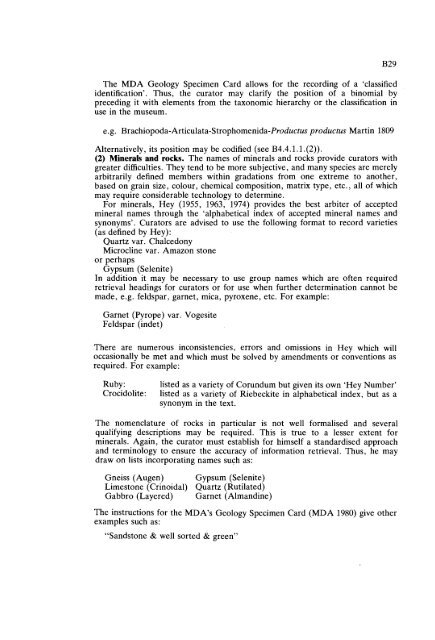GUIDELINES FOR THE CURATION OF GEOLOGICAL MATERIALS
GUIDELINES FOR THE CURATION OF GEOLOGICAL MATERIALS
GUIDELINES FOR THE CURATION OF GEOLOGICAL MATERIALS
You also want an ePaper? Increase the reach of your titles
YUMPU automatically turns print PDFs into web optimized ePapers that Google loves.
The MDA Geology Specimen Card allows for the recording of a 'classified<br />
identification'. Thus, the curator may clarify the position of a binomial by<br />
preceding it with elements from the taxonomic hierarchy or the classification in<br />
use in the museum.<br />
e.g. Brachiopoda-Articulata-Strophomenida-Productusproductus Martin 1809<br />
Alternatively, its position may be codified (see B4.4.1.1. (2)).<br />
(2) Minerals and rocks. The names of minerals and rocks provide curators with<br />
greater difficulties. They tend to be more subjective, and many species are merely<br />
arbitrarily defined members within gradations from one extreme to another,<br />
based on grain size, colour, chemical composition, matrix type, etc., all of which<br />
may require considerable technology to determine.<br />
For minerals, Hey (1955, 1963, 1974) provides the best arbiter of accepted<br />
mineral names through the 'alphabetical index of accepted mineral names and<br />
synonyms'. Curators are advised to use the following format to record varieties<br />
(as defined by Hey):<br />
Quartz var. Chalcedony<br />
Microcline var. Amazon stone<br />
or perhaps<br />
Gypsum (Selenite)<br />
In addition it may be necessary to use group names which are often required<br />
retrieval headings for curators or for use when further determination cannot be<br />
made, e.g. feldspar, garnet, mica, pyroxene, etc. For example:<br />
Garnet (Pyrope) var. Vogesite<br />
Feldspar (indet)<br />
There are numerous inconsistencies, errors and omissions in Hey which will<br />
occasionally be met and which must be solved by amendments or conventions as<br />
required. For example:<br />
Ruby:<br />
Crocidolite:<br />
listed as a variety of Corundum but given its own 'Hey Number'<br />
listed as a variety of Riebeckite in alphabetical index, but as a<br />
synonym in the text.<br />
The nomenclature of rocks in particular is not well formalised and several<br />
qualifying descriptions may be required. This is true to a lesser extent for<br />
minerals. Again, the curator must establish for himself a standardised approach<br />
and terminology to ensure the accuracy of information retrieval. Thus, he may<br />
draw on lists incorporating names such as:<br />
Gneiss (Augen) Gypsum (Selenite)<br />
Limestone (Crinoidal) Quartz (Rutilated)<br />
Gabbro (Layered) Garnet (Almandine)<br />
The instructions for the MDA's Geology Specimen Card (MDA 1980) give other<br />
examples such as:<br />
"Sandstone & well sorted & green"

















